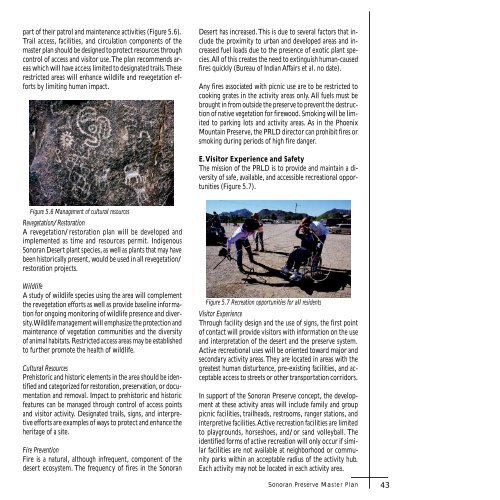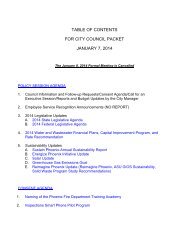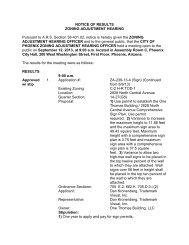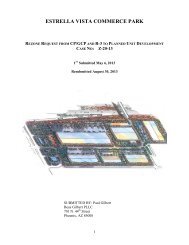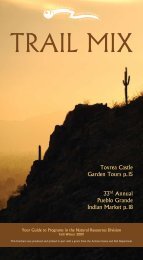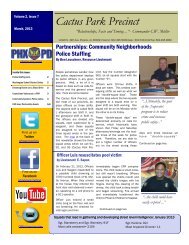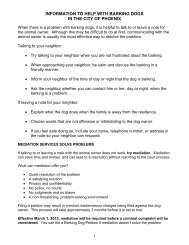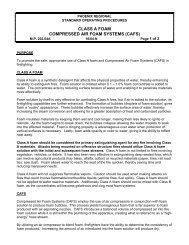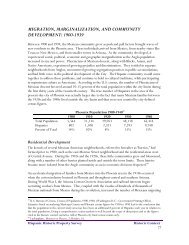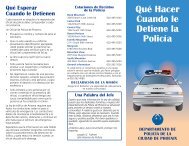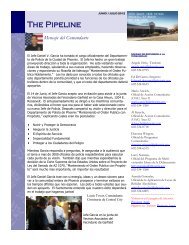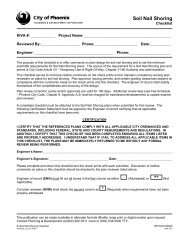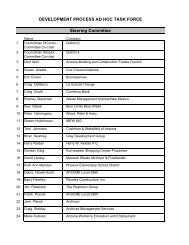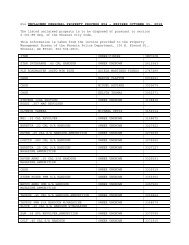Sonoran Preserve Master Plan - City of Phoenix
Sonoran Preserve Master Plan - City of Phoenix
Sonoran Preserve Master Plan - City of Phoenix
Create successful ePaper yourself
Turn your PDF publications into a flip-book with our unique Google optimized e-Paper software.
part <strong>of</strong> their patrol and maintenance activities (Figure 5.6).<br />
Trail access, facilities, and circulation components <strong>of</strong> the<br />
master plan should be designed to protect resources through<br />
control <strong>of</strong> access and visitor use. The plan recommends areas<br />
which will have access limited to designated trails. These<br />
restricted areas will enhance wildlife and revegetation efforts<br />
by limiting human impact.<br />
Figure 5.6 Management <strong>of</strong> cultural resources<br />
Revegetation/Restoration<br />
A revegetation/restoration plan will be developed and<br />
implemented as time and resources permit. Indigenous<br />
<strong>Sonoran</strong> Desert plant species, as well as plants that may have<br />
been historically present, would be used in all revegetation/<br />
restoration projects.<br />
Wildlife<br />
A study <strong>of</strong> wildlife species using the area will complement<br />
the revegetation efforts as well as provide baseline information<br />
for ongoing monitoring <strong>of</strong> wildlife presence and diversity.<br />
Wildlife management will emphasize the protection and<br />
maintenance <strong>of</strong> vegetation communities and the diversity<br />
<strong>of</strong> animal habitats. Restricted access areas may be established<br />
to further promote the health <strong>of</strong> wildlife.<br />
Cultural Resources<br />
Prehistoric and historic elements in the area should be identified<br />
and categorized for restoration, preservation, or documentation<br />
and removal. Impact to prehistoric and historic<br />
features can be managed through control <strong>of</strong> access points<br />
and visitor activity. Designated trails, signs, and interpretive<br />
efforts are examples <strong>of</strong> ways to protect and enhance the<br />
heritage <strong>of</strong> a site.<br />
Fire Prevention<br />
Fire is a natural, although infrequent, component <strong>of</strong> the<br />
desert ecosystem. The frequency <strong>of</strong> fires in the <strong>Sonoran</strong><br />
Desert has increased. This is due to several factors that include<br />
the proximity to urban and developed areas and increased<br />
fuel loads due to the presence <strong>of</strong> exotic plant species.<br />
All <strong>of</strong> this creates the need to extinguish human-caused<br />
fires quickly (Bureau <strong>of</strong> Indian Affairs et al. no date).<br />
Any fires associated with picnic use are to be restricted to<br />
cooking grates in the activity areas only. All fuels must be<br />
brought in from outside the preserve to prevent the destruction<br />
<strong>of</strong> native vegetation for firewood. Smoking will be limited<br />
to parking lots and activity areas. As in the <strong>Phoenix</strong><br />
Mountain <strong>Preserve</strong>, the PRLD director can prohibit fires or<br />
smoking during periods <strong>of</strong> high fire danger.<br />
E. Visitor Experience and Safety<br />
The mission <strong>of</strong> the PRLD is to provide and maintain a diversity<br />
<strong>of</strong> safe, available, and accessible recreational opportunities<br />
(Figure 5.7).<br />
Figure 5.7 Recreation opportunities for all residents<br />
Visitor Experience<br />
Through facility design and the use <strong>of</strong> signs, the first point<br />
<strong>of</strong> contact will provide visitors with information on the use<br />
and interpretation <strong>of</strong> the desert and the preserve system.<br />
Active recreational uses will be oriented toward major and<br />
secondary activity areas. They are located in areas with the<br />
greatest human disturbance, pre-existing facilities, and acceptable<br />
access to streets or other transportation corridors.<br />
In support <strong>of</strong> the <strong>Sonoran</strong> <strong>Preserve</strong> concept, the development<br />
at these activity areas will include family and group<br />
picnic facilities, trailheads, restrooms, ranger stations, and<br />
interpretive facilities. Active recreation facilities are limited<br />
to playgrounds, horseshoes, and/or sand volleyball. The<br />
identified forms <strong>of</strong> active recreation will only occur if similar<br />
facilities are not available at neighborhood or community<br />
parks within an acceptable radius <strong>of</strong> the activity hub.<br />
Each activity may not be located in each activity area.<br />
<strong>Sonoran</strong> <strong>Preserve</strong> <strong>Master</strong> <strong>Plan</strong><br />
43


